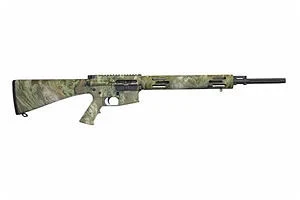Bushmaster Max 1 Predator vs Tula Arsenal SKS M56
Put rifles head to head to compare caliber and more.
|
$1041.00
|
vs |
$0.00
|
| Rifles | Bushmaster Max 1 Predator | Tula Arsenal SKS M56 |
|---|---|---|
| Summary | ||
| Rating | ||
| Rank | ||
| Weight | 120 oz | |
| Action | Semi-Automatic | |
| Caliber | .223 Remington | 7.62x39mm Soviet |
| Capacity | 5+1 | 17+1 |
| Finish | Camo, Blue Barrel | Black |
| Gun Type | Rifle | Semi-Automatic |
| Sights | No Sights | Adjustable w/ Tritium Front Post & 2-Dot Tritium Rear Aperture |
| Details | ||
| Brand | Bushmaster | |
| Reviews | See 2 Reviews | N/A |
| Prices | ||
| MSRP | $1,015.00 | $0.00 |
| Used Price | $710.50 | $0.00 |
| Sale Price | $913.50 | $0.00 |
Rifles Descriptions
Bushmaster Max 1 Predator
Built as a result of numerous requests by the hunters who wanted a slightly shorter barrel and lighter swing weight in a carry rifle for predator hunting/calling, this 20� barreled version of the Varminter will deliver all the accuracy you�ve come to expect from a Bushmaster.
Tula Arsenal SKS M56
The SKS is a gas-operated semi-automatic rifle feeding from a ten-round non-detachable box magazine. Compared to modern firearms, the SKS has a "decidedly eclectic appearance", with a steel receiver with John Browning-esque design elements, a full wooden wraparound handguard (what type of wood used was dependent on who made it), sloped magazine extension, protruding gas tube and most notably, a folding bayonet (what type of bayonet was used was also dependent on who made it, and in a few cases, how early or late it was in its production cycle). The SKS may bear somewhat of a passing resemblance to an AK, although both weapons are very different fundamentally; the AK-47 features a rotating bolt, while the SKS features a tilting bolt noted to be very similar to that of the PTRS Simonov designed a few years prior; the action is noted to be practically identical to that a shrunken PTRS with various changes, including the trigger, magazine feed and the ability to access the floorplate with the bolt closed. When the weapon fires, the bolt carrier is pushed rearwards, causing the bolt to get lifted and get unlocked as it is carried rearwards using a spring. This causes the spent casing to be extracted, ejected and a new round loaded in. The receiver cover houses both the receiver, a receiver spring and a bolt catch.



